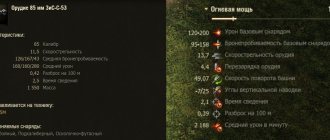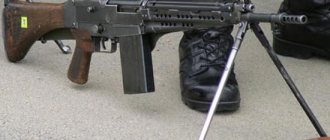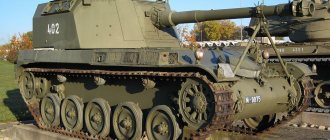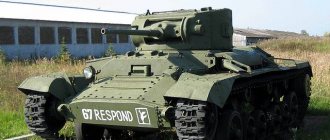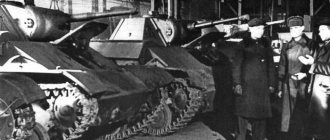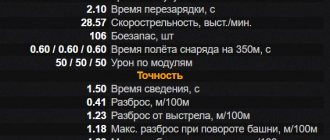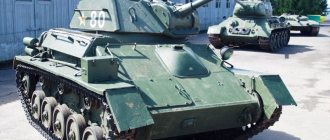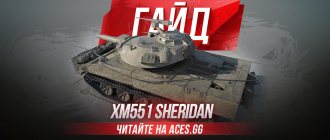Disadvantages of the T92 light tank
✔ The worst maximum speed of all Tier VIII light tanks, but at the same time it “turns around” faster than many
✔ Tank gun level VII T71 DA. The armor penetration of AP shells is only 175 mm, which is not always enough even for tanks of its level, and if we add here the exorbitant price of a cumulative shell of 5600 silver and low one-time damage, it becomes quite sad
✔ Lack of armor, but what is supposed to be there will protect you no more than gauze panties
Russian tanks against Western ones. What are Western ratings silent about? Let's watch real combat experience
Russian tank T-90
More than a century has passed since the advent of tank building. During this time, tanks have become full-fledged and autonomous combat units on the battlefield, and their combat characteristics are improving every day.
At the current moment in time, when there are no global wars, the quality and effectiveness of a particular tank is monitored in local military conflicts. Therefore, the tanks of the leading powers do not collide directly on the battlefield, which is of course for the better, but the virtual ratings of comparisons of tanks that the West “sculpts” are hardly close to reality, and it is not possible to verify this information in practice.
German tank "Leopard-2"
According to Western analysts, the leading tanks in the world tank building today are: the German Leopard 2, the American Abrams A1M1, the French Leclerc, the British Challenger and the Israeli Merkava tank.
Where are the Russian tanks?
Russian tanks are used as “whipping boys”, comparing the Soviet T-72, T-80 and T-90 with the latest Western models, of course without fresh modifications, placing them in the last positions of various ratings.
Israeli main tank Merkava
How true is this and what does the real experience of using Western and Russian tanks say?
A1M1 Abrams tank during the military conflict in Iraq. "Abrams" were destroyed not only by a direct hit from the Soviet RPG-7, but also from a heavy machine gun, which pierced the armor protecting the additional engine that promoted the rotation of the turret, as a result the tank failed and often burned out. Moreover, the dust and sand typical of the region often caused damage to the main engines of the “best” tanks in the world.
A1M1 "Abrams"
As for the Israeli Merkava tank, during the fighting of the Second Lebanon War, 30 out of 50 tanks were destroyed, and this is only according to official data.
The German Leopard 2 tanks were destroyed, in the literal sense of the word, by the war in Syria, where German tanks in service with Turkey were scattered into pieces after being hit by just one ATGM missile. The detonation of poorly placed ammunition left the tank no chance.
French tank "Leclerc"
The French Leclerc tank is rarely used anywhere, since it is an extremely expensive vehicle with questionable effectiveness for the money.
As for the Russian T-90 tank, the statistics are quite interesting. During the entire period of hostilities in Syria, only one tank was completely destroyed, and that was due to the illiteracy of the Syrian military. The crew abandoned the tank and the militants blew it up from the inside, stuffing it with explosives.
Comparison of Western main tanks with T-90S
Moreover, indicators such as targeted firing range (5 km versus 2 km of a German tank), speed and accuracy of hits while moving, and the latest active protection systems make the tank no worse than leading Western models, and often even better. And of course, the West should not forget about the latest Russian development - the T14 Armata tank.
To summarize, we can confidently say that Russian tanks do not need any foreign ratings to prove their superiority to anyone, the facts speak for themselves.
Profitability of the T92 light tank (farm)
Farming T92 is generally not bad, if you carefully analyze the post-battle screenshots, farming is much more financially profitable than damaging. But again, if you don’t shoot, the efficiency of the WN8 will rapidly begin to fall, so try to combine the pleasant with the useful. That is, do not shoot at the beginning of the battle and actively “jackal” when there are few enemy tanks left, and as a result they will be distracted by a firefight with “serious” allies
Moscow and the mirage of the T-92 tank prevent Gaddafi from being defeated
Mountains of Soviet-made weapons have accumulated in North Africa. Damaged T-72 tank in Libya. Photo by Reuters
The representative of the National Transitional Council of Libya, Mahmoud Awad Shammam, complained about the lack of weapons among the Libyan opposition. According to him, Muammar Gaddafi’s regime is receiving “the latest Russian-made weapons,” including T-92 tanks. The Libyan's statement caused bewilderment among NG experts. The T-92 tank does not exist in nature; in addition, given Gaddafi’s solid tank fleet, the disgraced Libyan leader has no need to import additional vehicles at all.
“Gaddafi is still getting weapons,” said Mahmoud Awad Shammam. “We know for sure that just yesterday 500 vehicles with weapons arrived from Algeria. The sea is open from the Eastern European countries. This is where the latest Russian-made weapons come from – T-92 tanks, which are used in the battles against Misrata.”
The translation of the same quote by Shammam into the main European languages, published on the website euronews.net, has significant differences. The English version says: “The coast on the Eastern European side is completely open, and he (Gaddafi - NG) is buying the latest weapons - Russian-made T-9 and T-2 tanks, which are used against Misurata.” In the French version, like in the Italian, the index of the mysterious Russian tank is not indicated. The hope of finding the truth among the punctual Germans was not justified: “Eastern European countries supply him (Gaddafi - NG) with the latest Russian technologies, which he uses against Misurata.” Shammam's statement is puzzling. In nature, there is no Russian tank under the symbol T-92 (as well as T-9 or T-2). There is a T-90, but its production has been stopped.
Uralvagonzavod in Nizhny Tagil, which is engaged in its production, did not receive a state defense order for 2011. And it is unlikely to receive it before 2013. In the Armed Forces of the Russian Federation, in the new look brigades, according to the Ministry of Defense of the Russian Federation, modern weapons are already only 6%. So no one will take the few T-90s out of service and send them overseas. Moreover, they can only be replaced with old models produced in the 1980s at best, that is, those that have served for more than 20 years.
In addition, Russia does not give away weapons for free. Only by prepayment. A contract must first be concluded with Rosoboronexport. Only this Federal State Unitary Enterprise has the right to export Russian weapons. The procedure for exporting military products is cumbersome and highly bureaucratic - you need to obtain permission from about 40 authorities. We should not forget that Russia joined the sanctions against the Gaddafi regime.
The Russian Foreign Ministry was unable to comment on the situation yesterday. Leading experts in the West are also not inclined to believe the Libyan rebel’s claims. Thus, Peter Wezeman, an expert on the arms supply program at the Stockholm Peace Research Institute (SIPRI), told NG: “I have not seen evidence confirming the statement of Mahmoud Shammam. Until we have real footage of the T-92 (T-90?) in Misrata or a reliable report from, say, the UN Sanctions Committee, I cannot believe it.”
In Eastern European countries, except Russia, the T-90 is not in service. The only country where it was definitely supplied was India. A contract was signed with Algeria in 2006 for the sale of 180 units. Later, under two additional contracts, their number was increased to 300 with a delivery period until 2011. However, back in 2009, approval of the T-90 configuration in the Algerian version continued. According to available data, Uralvagonzavod never started fulfilling the contracts. In addition, Russia sells weapons with strict conditions not to transfer them to other countries. So the Algerian army cannot be a supplier of T-90s to the Gaddafi regime. Former Warsaw Pact members from Eastern Europe who had Soviet weapons almost all joined NATO. They are unlikely to supply Gaddafi. What remains are the post-Soviet countries - Ukraine, Belarus, Moldova. According to expert estimates, over the past 20 years they have already sold everything they could. And the tanks they have were produced before 1990. These can be models T-54, T-62 and T-72. Unmodernized, physically and morally obsolete for 25–35 years that have passed since the date of their manufacture. Such goods are always available on the arms market of developing countries at a price of 100 to 500 thousand dollars, or even 50–70 thousand.
| There is a lot of Soviet-made equipment in North Africa, including in the arsenal of the Libyan army. Photo by Reuters |
Alexey Arbatov, head of the Center for International Security at IMEMO RAS, in an interview with NG, suggested that the Libyan could have meant the T-72. Under the Russian embargo, such a supply to Libya is impossible. “But Russia has flooded the Middle East with military equipment. Both sides are fighting with Russian weapons, because previously Libya was one of the leading importers of our equipment, like the surrounding countries. Even under the conditions of the arms embargo, there will be enough for another 10 years of war.” After the collapse of state structures in a number of North African countries, mountains of weapons were left virtually uncontrolled. “There were clever guys who would carry them back and forth across the border and deliver them to the highest bidder,” the expert said.
Indeed, in television reports from near Misrata you can see how T-55 tanks of the 1958 model are burning. The first modifications of the T-72 also flashed on the screens. Libya had a substantial tank fleet. In Gaddafi's army there were in service: T-54/55 - 500 units, T-62 - 100, T-72 - 200. Another 1225 tanks of various models were in storage. With the intensity of hostilities that we are seeing, these reserves may last for years. So there is no point in bringing even a hundred or two tanks from overseas.
The Libyan opposition is fighting poorly. They are undisciplined, poorly trained, and have not established normal supplies, communications and management. Claims of Russian tanks at Misrata may serve to justify their defeats. But most importantly, they reinforce the demand for Western countries to give weapons to the rebels. And since the Libyans do not know how to handle them, they will have to supply instructors, technical personnel, and advisers along with the weapons. By and large, we are talking about involving the Europeans in a ground operation against Gaddafi. For this, both the “hand of Moscow” and the non-existent T-92 tank will do.
What equipment to install on the T92 light tank
It all depends on what you are aiming for: extracting maximum profit or, on the plus side, you want to keep the efficiency of WN8 at the same level.
To get the most income:
★ Coated optics
★ Stereo tube
★ Improved ventilation Class 1
If you are more interested in the efficiency of the WN8, improved ventilation and a stereo tube, it makes sense to replace it with:
★ Medium caliber gun rammer
★ Vertical stabilizer Mk 1
LIGHT TANK THAT REMAINED UNKNOWN
The M551 Sheridan light tank, which entered service with the US Army in 1966, created a sensation among specialists. A hull made of aluminum alloys, a 152-mm gun - the Shilleila ATGM launcher, the ability to be transported by aircraft and parachute landing - all this was a new word in design and tactics for use for US tanks, and for most light tanks in the rest of the world. True, the value of these innovations turned out to be controversial, but that’s not even the point... Everything mentioned is well known to many tank history buffs. It is much less known that if the cards had been laid out differently, the American army would have received a completely different, although no less interesting, T92 light tank.
New US light tank
Starting the story about this vehicle, I would like to briefly dwell on the history of American light tanks.
Having entered World War II with the 12-ton M3 Stuart, armed with a 37-mm cannon, American tank crews successively switched to the M5 and then to the M24 Chaffee . This tank already weighed 16.5 tons and had a much more powerful 76-mm gun. The next step in “making the light tank heavier” was the appearance in 1951 of the M41 Walker Bulldog, which was virtually identical in design. The 24-ton vehicle, which surpassed many medium tanks of World War II in firepower and weight, became a kind of “crown of development” of the “classical” way of improving a light tank. An attempt to go further along this path was the creation at the beginning of 1953 of the T49 tank, armed with a 90-mm cannon and weighing more than 25 tons. Despite the good results shown in the tests, the American military decided that it was pointless to go this route, since the result was a tank that was too heavy and expensive for a light one and too weakly armed (as it was inferior in ammunition and sighting devices) and armored for a medium one.
In May 1952, the Armaments Committee announced requirements for a new light tank, which was supposed to replace the M41. Initially, it was assumed that the mass of the new vehicle would be 20 tons, later this figure was reduced to 18. They wanted to arm the tank with a 90-mm gun, which would give it the ability to effectively fight almost all armored vehicles of a potential enemy, but according to the results of preliminary studies carried out by specialists from the Detroit Arsenal, it became clear that we would have to limit ourselves to a 76-mm gun, but it would need to be equipped with an automatic loader. More than a dozen very diverse projects were submitted to the competition. In June 1953, at a meeting in Fort Knox, three contenders for victory in the competition were determined.
The first of these was developed at the Detroit Arsenal and was an 18-ton tank armed with a 76 mm cannon in a low, uninhabited turret. The gun's ammunition capacity was 60 rounds, 18 of which were placed in the automatic loader. The presence of the latter made it possible to reduce the crew to three people. Two of them, the tank commander and the gunner, were located in the turret. The place of the third crew member, the driver, was located in the center of the front of the hull. The armor protection corresponded to that of its predecessor, the Walker Bulldog tank. In the rear part there was a transversely mounted 340-horsepower AOI-628 carburetor engine and an XT-270 gearbox, which transmitted drive torque to the rear drive sprockets. The four road wheels had a torsion bar suspension. The suspension was complemented by front idler wheels and three support rollers per side.
| Experienced light tank T71 1 – support roller; 2 – drive sprocket; 3 – 76-mm T185 gun; 4 – commander’s cupola with a 12.7 mm machine gun; 5 – gunner’s hatch; 6 – driver's hatch. |
A second project was proposed. The T71 tank was a relatively light (17 tons) vehicle with a 76-mm T185 cannon located in a conventional (inhabited) turret. The gun was the same M32 cannon that was installed on the Walker Bulldog, but equipped with a quick loader. The tank's crew consisted of four people, three of them - the commander, gunner and loader were located in the turret, and the driver sat on the left in front of the hull. The armor was no different from the M41. The power plant was an AOI-628-1 engine that drove drive sprockets located, unlike the previous project, in the front part of the hull. The design of the chassis, which had four large-diameter road wheels with a torsion bar suspension on board, made it possible to do without support rollers. The fuel supply was 570 liters, which provided the T71 with a cruising range of 265 kilometers.
The third light tank project was developed by the designers (AAI). Weighing just under 17 tons, it was very different from its competitors. The 76-mm cannon and the coaxial 7.62-mm machine gun were mounted not in a conventional turret, but on an outrigger carriage shifted to the stern, which significantly reduced the height of the tank. The commander and gunner, who were located, respectively, to the left and right of the gun, each received their “own” turret with a heavy machine gun. The loader was behind the tank commander. The fourth crew member, the driver, sat in the front of the car to the left of the engine. The power unit was an AOI-628-1 engine located across the body in a block with an XT-300 gearbox. The T92 chassis, applied to one side, included a front drive wheel and 4 paired road wheels, of which the latter played the role of a steering wheel. Support rollers were not initially provided. Suspension - balancer, torsion bar.
After considering all the projects, it was decided to build mock-ups of new tanks. As a result, on June 18, 1954, AAI received an order to build two prototypes of the tank, designated T92. At meetings on November 5, 1954 and January 27, 1955, numerous changes were made to the original design, most of which were turned into metal during the construction of prototypes. For example, the chassis received support rollers (2 per side), and a 7.62 mm machine gun was installed in the commander’s cupola instead of a 12.7 mm machine gun (leaving, however, the possibility of a reverse replacement).
The first T92 (No. 961281) arrived at the Aberdeen Proving Ground on November 2, 1956. Moreover, due to the fact that the machine gun turrets did not arrive on time, the tank conducted its first tests without them. The second prototype (No. 9B1282), which arrived in Aberdeen on July 22, 1957, already had a full set of weapons. The tests completely satisfied the military, and it was decided to launch the new vehicle into series.
Layout and device
| Experienced light tank T92 1 – drive sprocket; 2 – support roller; 3 – support roller; 4 – hydraulic shock absorber; 5 – spare tracks; 6 – 76-mm T185E1 gun; 7 – battery compartment hatch; 8 – driver’s hatch; 9 – 7.62 mm machine gun; 10 – gunner’s turret; 11 – left gas tank flap; 12 – right gas tank flap; 13 – commander’s turret; 14 – 12.7 mm machine gun; 15 – headlights; 16 – tank commander’s observation device; 17 – commander’s periscope; 18 – gunner’s periscope; 19 – gunner’s observation device; 20 – entrenching tool in a special basket; 21 – aft double door; 22 – exhaust system box; 23 – engine compartment cooling shutters. |
View of the engine compartment with open hatches: 1 – support holding the engine compartment hatch in the open position; 2 – rear exhaust manifold; 3 – engine compartment blinds; 4 – seal installed on the hatch along the perimeter of the fan opening; 5 – intake manifold; 6 – emergency shut-off valve of the fuel line; 7 – seal of the engine compartment hatch; 8 – power beam; 9 – throttle control rod (“gas”); 10 – control unit for on-board brakes; 11 – left support; 12 – rod of the throttle control range adjustment mechanism; 13 – right support; 14 – neck for pouring oil into the transmission; 15 – transmission oil filter hatch; 16 – protective frame of the throttle rocker arm; 17 – front exhaust manifold; 18 – fan seal; 19 – neck for pouring oil into the engine; 20 – engine crankcase breather. |
The hull of the T92 tank was welded from cast and rolled parts. The protection was equivalent to that of its predecessor, the M41 tank, but weighed less due to the greater angle of inclination of the armored parts and the use of light alloys for some of them. Thus, armor made of aluminum alloys was used for the hatches of the power plant compartments, batteries and auxiliary generator, and the cooling system shutters were made of light alloys and reinforced plastic.
The engine compartment was located on the right in the front part and was separated from the rest by a steel fire bulkhead. To the left of it was the auxiliary power unit compartment and batteries. Behind them was the driver's seat. To observe the battlefield, he used 4 M17 periscopes located around his hatch, in addition, there was space in the hatch cover to install an M19 infrared periscope. To evacuate from the tank, the driver, in addition to his own hatch, could use the emergency hatch, which was located under his seat.
The Allison XT-300 gearbox, interlocked with the engine, had six forward gears and two reverse gears. Air intake for engine operation was carried out through a fungus on the roof of the hull to the left of the turret, exhaust - through grilles in the rear of the right fender. Two soft 75-gallon fuel tanks were located in a compartment at the rear of the hull in front of the ammunition stowage. The chassis included (on each side) a front drive wheel, four road wheels with individual torsion bar suspension, the first and fourth (which also played the role of a sloth), of which were equipped with additional hydraulic shock absorbers, as well as two support rollers.
The steel track with rubber pads on the tracks had a width of 406 mm and a length of 9.91 meters. Two spare track sections (7 tracks each) were attached to the rear of the turret. In addition to the hatches in the upper armor plate, the tank had a double-leaf door in the rear of the hull, in each of the doors there was an observation device.
A special feature of the T92 was the turret ring, which was unusually large in diameter for a small vehicle - 2260 mm. The 76-mm T185E1 cannon was placed on a special external carriage mounted in the center of the turret between two armored machine-gun turrets. The T185E1 gun was developed on the basis of the M32 cannon mounted on the Walker Bulldog tank, with which it had the same ballistics and differed mainly in that it was adapted to work with an automatic loader. The cannon was paired with a 7.62 mm machine gun mounted above the gun. The right turret, armed with a heavy machine gun, was occupied by the tank commander, the left - by the gunner, who, unlike the original design, had a 7.62 mm machine gun. Each turret was equipped with two periscopes, the height of which allowed observation above the gun, and four observation devices, another 6 were located on the “main” turret. The turrets also had periscope sights for turret machine guns.
Both the commander and the gunner could guide and fire the gun, for which they each had an M16 periscope, which was installed on the “main” turret in front of the turrets. A telescopic sight was paired with the gunner's periscope. Both turrets had a rotation angle of 194°. The rotation of all three turrets and the vertical guidance of the gun could be controlled either electrically or manually and allowed vertical guidance angles of 10+60°. The fourth crew member, the loader, was located behind the gunner. Loading could be carried out either manually or using a loading mechanism, the magazine of which (7 shells) was located between the commander and gunner positions. In addition, shells were stored in the ammunition stowage at the rear of the hull (28 shells) and in the turret (24 shells). Together with the projectile in the loading mechanism, this gave an ammunition load of 60 projectiles. The small capacity of the loading mechanism magazine required the loader to either reload it during the battle (which was quite possible, although inconvenient), or to switch to loading the gun (or rather the loading mechanism, since the shells in this case were loaded not into the gun itself, but into feed mechanism) manually. Spent cannon and machine gun cartridges were thrown out of the tank through special hatches.
Gunner's turret: 1 – hatch cover; 2 – armored cover of the periscope; 3 – canvas cover; 4 – armor cover for a machine gun mount; 5 – hole for ejecting spent cartridges; 6 – machine gun mount axis; 7 – eye for lifting the turret; 8 – turret body; 9 – seal around the perimeter of the shoulder strap; 10 – viewing device; 11 – hatch balancing mechanism. | Driver's hatch: 1 – head of infrared periscope M19; 2 – rotating periscope base; 3 – periscope M17; 4 – hatch cover; 5 – protective frame of the driver’s viewing devices; 6 – periscope M17. |
Closing the program
Tests carried out at the Aberdeen Proving Ground revealed a number of shortcomings. So, the track kept breaking down, and after 202 hours of testing it was replaced with a track with 356 mm T85E1 tracks, standard for the Chaffee tank. Due to the observed tendency for the tracks to fall off, it was decided to add a rear idler wheel to the chassis. Other changes made based on the test results include strengthening the transmission elements, moving the heater to the left rear part of the engine compartment, installing an additional turret ring seal, etc. (about 50 improvements in total).
The funds allocated in 1957 for the production of two more T92s, which were to become standards for the series, were spent on modernizing the first two vehicles based on test results. The production of the 3rd and 4th tank samples was postponed until next year, having decided at the same time to make all changes to their design. Looking ahead, I will say that they were never built.
| Performance characteristics of some light tanks from other countries |
It seemed that not even a year would pass before the first T92 would appear in service with the US Army, but clouds began to gather over its fate. Back in early 1957, a special committee of Congress received intelligence reports that light amphibious tanks PT-76 . This information led to a revision of the entire design concept for US light tanks. So, it was decided to make them floating. Unfortunately, it was not possible to ensure the buoyancy of the T92, since even at the design stage they tried to reduce the reserved volume as much as possible. To make a tank amphibious, it was necessary to increase its size to ensure an acceptable displacement, which negated almost all of its advantages. And so in June 1958, a decision was made to stop work on the new light tank program, including the construction of the third and fourth T92. Thus ended the fate of this interesting car. Both tanks produced were used for various tests for several years. One of these vehicles can now be seen in the tank museum in Aberdeen.
Performance characteristics of light tanks of the US Army of the 50s of the XX century
Join our group “Courage 2004”
Share on social networks:
TTX T92
Let's start our review traditionally with the viewing radius.
This LT has an excellent visibility range of 400 meters. This is already quite a sufficient result for a comfortable game, but if desired, you can always achieve maximum results using “coated optics,” for example. The mass of the tank is almost 17 tons. Engine power – 340 horsepower. In total, we have a specific power indicator of 20.02 hp/t.
Specific power affects the maneuverability of the tank, which, by the way, is excellent here. The maximum forward speed of the T-92 is 60 km/h, the rear speed is 25 km/h. Such a speed in reverse adds comfort not only in driving the tank back, but also in confusing the enemy.
The chassis rotation speed is 55 degrees/s, the turret rotation speed is 52.1 degrees/s.
Due to the well-designed body, we get good camouflage coefficients, and when using camouflage, the result will be simply excellent.
Excerpt characterizing the T92 (tank)
Count Ilya Andreich, smiling sweetly, nodded his head approvingly. – So, did our militias really benefit the state? No! They just ruined our farms. It’s better to have another set... otherwise neither a soldier nor a man will return to you, and only one debauchery. The nobles do not spare their belly, we ourselves will all go, take another recruit, and all of us just call the goose call (that’s how the sovereign pronounced it), we will all die for him,” the speaker added with animation. Ilya Andreich swallowed his drool with pleasure and pushed Pierre, but Pierre also wanted to talk. He stepped forward, feeling animated, not yet knowing why and not yet knowing what he would say. He had just opened his mouth to speak when one senator, completely without teeth, with an intelligent and angry face, standing close to the speaker, interrupted Pierre. With a visible habit of leading debates and holding questions, he spoke quietly, but audibly: “I believe, dear sir,” said the senator, muttering with a toothless mouth, “that we are not called here to discuss what is more convenient for the state at the present moment.” - recruitment or militia. We are called to respond to the appeal with which the Emperor has honored us. And we will leave it to the higher authorities to judge what is more convenient - a conscription or a militia... Pierre suddenly found an outcome to his animation. He became bitter against the senator, who introduced this correctness and narrowness of views into the upcoming occupations of the nobility. Pierre stepped forward and stopped him. He himself did not know what he would say, but he began animatedly, occasionally bursting into French words and expressing himself bookishly in Russian. “Excuse me, Your Excellency,” he began (Pierre was well acquainted with this senator, but considered it necessary to address him here officially), “although I do not agree with Mr.... (Pierre paused. He wanted to say mon tres honorable preopinant), [my esteemed opponent,] - with Mr.... que je n'ai pas L'honneur de connaitre; [whom I do not have the honor to know] but I believe that the class of nobility, in addition to expressing its sympathy and admiration, is also called upon to discuss the measures by which we can help the fatherland. I believe,” he said, inspired, “that the sovereign himself would be dissatisfied if he found in us only the owners of the peasants whom we give to him, and ... the chair a canon [fodder for guns] that we make of ourselves, but I wouldn’t find any co…co… advice in us. Many moved away from the circle, noticing the senator’s contemptuous smile and the fact that Pierre spoke freely; only Ilya Andreich was pleased with Pierre’s speech, just as he was pleased with the speech of the sailor, the senator, and in general always with the speech that he last heard. “I believe that before discussing these issues,” Pierre continued, “we must ask the sovereign, most respectfully ask His Majesty to communicate to us, how many troops we have, what is the situation of our troops and armies, and then...”
Advantages and disadvantages
To systematize the knowledge gained, we will analyze all the characteristics of the strengths and weaknesses of the machine.
Pros:
- mobility and maneuverability;
- high DPM;
- UVN;
- excellent viewing radius;
- camouflage coefficient.
Minuses:
- bad booking;
- margin of safety;
- low armor penetration rate;
- can only be purchased as part of WoT promotions;
- spread 100 meters;
- insufficient number of shells.
Links
Medium tanks M46 "Patton" · T42 M47 Patton II
T69
M48 Patton
III T54
T77Heavy tanks M103 TV-1** ·
R32**
·
"Hunter"Main battle tanks FMBT T95
T96
M60
MBT
-
70
MCS
XM803 M1 Abrams _BMP XM701 AIFV*
XM723
M2/M3 Bradley LAV-25 GCVArmored personnel carriers M44 M75 M59 M113 V-100 Commando M1117 Cougar M1126 Stryker
MULE-T
International MaxxPro
Chita
Cayman Bull GrizzlyAmphibious armored personnel carriers LVTP5 AAV7 EFV BRM and KShM AHED ARV
-
AL ARV-R
M114 Lynx*
XM800T
XM800W
XM808
Twister
Commando Scout*
Crusher
M- ATVSelf-propelled howitzers M44 M52 M53/M55 T162
M107 M108 M109 M110
NLOS
-
C XM62
XM104
XM138 XM2001
CrusaderSelf-propelled mortars M84 M106 M125 M1064 M1129 ZSU T100 · M42 ·
T249
· M163 ·
XM166
· M247 "Sergeant York"Anti-tank self-propelled guns M56 M50 "Ontos" MLRS M270 MLRS HIMARS Self-propelled guns XM124E2 ·
M2A2 Terra-StarFlamethrower tanks and mechanized flamethrowers M67 M132 Engineering vehicles M728 Buffalo MPV MULE-C BREM M74 M51 M578 M88 Remote controlled ARV-A ARV
-H
TUGV Gladiator
Black Knight
XM1219Self-propelled laser systems Laser Avenger Other Quadruped Transporter * - produced only for export; ** - projects nuclear powered tanks ;
Italics
indicate experimental samples and those that did not go into mass production
Crew training
It is important to choose the necessary perks the first time, so that there is no need to waste time correcting mistakes. We suggest training the crew as follows:
- Commander (radio operator) – “The Sixth Sense”, “Repair”, “Combat Brotherhood”, “Radio Interception”;
- Gunner – “Repair”, “Smooth rotation of the tower”, “Combat brotherhood”, “Disguise”;
- Driver - “Repair”, “Smooth ride”, “Combat brotherhood”, “Disguise”;
- Loader – “Repair”, “Radio interception”, “Non-contact” ammunition rack, “Camouflage”.
Alexey Khlopotov “The Fiery Heart of Russian Tanks”
Home » Tanks of the present and future » Alexey Khlopotov “The fiery heart of Russian tanks”
Tanks of the present and futureTanks of the present and future
byakin 03/20/2019 2552
12
in Favoritesin Favoritesfrom Favorites 8
Abstract: In the vastness of the RuNet I found a LiveJournal of an interesting person dedicated to armored vehicles. I was interested in a series of articles in this magazine, which I decided to repost on the site as a single article.
Lately, Russian armored vehicles have been under fire. This is understandable; with the best price/quality ratio, Russian tanks provide serious competition to all others on world markets. For this reason, there are quite a few who want to spoil the image of Russian tanks and tank builders. Engine building was chosen as one of the areas of criticism of Russian tank building by such “benevolent experts”. Some gentlemen who have Ukrainian registration, but for some reason care about “domestic” - that is, “Russian” armored vehicles, are sounding the alarm bell about the absence in Russia of a promising special-purpose engine for heavy armored vehicles. It is stated that work in this direction has been going on for 20 years, but all without success. Is this really so? Let's give the floor directly to the person who in the Russian Federation is responsible for providing armored vehicles with such engines:
“...The most advanced engine of the 2B family is the A-85-3 engine. Its creation was carried out in relation to a promising product. To date, 16 samples of this engine have been manufactured. The first 2 samples were subjected to CDI in the amount of 1704 hours. The remaining samples were used for control tests. Long-term bench tests, a set of special tests (for reliability, in high altitude conditions, on low-viscosity oils, start-up tests), as well as MVI and sea trials were carried out. The design of the A-85-3 engine includes technical solutions that allow it to remain at the same level for many years foreign analogues in terms of basic indicators, and even surpass them in overall power.”
© Murzin Vladimir Stanislavovich, director - chief designer of GSKB "Transdiesel" (magazine "Arsenal. Military-Industrial Review", No. 5 2011)
And here is actually this engine itself, photographed by me in 2010, so that you, dear reader, could really be convinced of its existence. Of course, some may say that this is just an exhibition model, but I assure you that exactly the same ones were installed on our promising tanks that recently underwent State tests. In terms of the power plant, the tests were completed successfully; the engine had no complaints. At the same time, there was an incident in Yurga (Siberian Military District), when the crew drove the car into snowdrifts from which it could no longer get out on its own. At the same time, the automatic system was activated, protecting the power plant from overheating. The rated engine power is 1500 hp, the power of the derated version is 1200 - 1350 hp. with a significant increase in service life, power with boost is 1800-2000-2200 hp.
A-85-3, aka 2A12-3, aka 12ChN15/16, aka 12N360...
Currently, some of them have been declassified and posted on the official website of ChTZ. Let me bring them here and add a little of my own:
Engine type: Four-stroke, X-shaped, 12-cylinder with gas turbine turbine supercharging and intermediate air cooling. Liquid cooling.
Mixture formation system: direct fuel injection
Piston: composite with gallery cooling
Engine power without resistance at inlet and outlet, kW (hp)………1103 (1500) Rotation speed, s-1 (rpm)…………………………………………………………… …………………………33.3 (2000) Torque reserve, %…………………………………………………………………………………..25 Adaptability coefficient……………………………………………………………………………….1.2-1.25 Working volume, l…………………………………… ………………………………………………………34.6 Compression ratio…………………………………………………………… ……………………………..11 Specific fuel consumption, g/kW*h (g/hp*h)……………………………………………………………… …..217.9 (160) Weight, kg…………………………………………………………………………………………………………………… ..1550 Specific power, kW/kg (hp/kg)………………………………………………………………0.74 (1.0) Overall power, kW/m3 (hp/m3)………………………………………………………..1026 (1395) Liter power, kW/l (hp. s./l)…………………………………………………………………………………31.88 (43.35)
Diesel engines produced by ChTZ for military and civilian purposes on display to the Russian leadership 12/08/2009
X-shaped diesel engines are not installed on T-90 type tanks and in particular on the just presented T-90MS TAGIL tank. Why? Yes, because these engines are tailored specifically for completely different promising cars. To ensure the operation of this new engine, new systems are also needed. First of all, cooling, air purification, power supply, exhaust, etc. and so on. Of course, they can be crammed into the T-90 MTO, moreover, in the mid-1980s, this was already done on the experimental Object 186 tank. True, the larger predecessor of the 2V-12, the 16-cylinder 2V-16, was installed there, and in order to accommodate radiators of an increased area, the tank had to roll the stern back even more, which is not very rational and effective, especially from technological and economic point of view. In the end, “X-patterns” are simply not needed on the T-90. Tanks of the T-72 and T-90 types have enough reserves that the “old” proven diesel engines of the V-2 type still have. Their modernization potential is far from being exhausted. With the development of new technologies, including the currently fashionable “nano” technologies, it is possible to continue increasing capacity. Moreover, in relation to tanks of the 45-50-ton class, which include the T-72 and T-90, further increase in power is not a priority. Research conducted by leading Russian industrial scientific institutes: VNIITM, NIID, 38NII of the RF Ministry of Defense, many years of experience in large-scale military operation show that the power unit power density indicator is optimal in the range of 20-25 hp/t. Exceeding this value is impractical both technically and economically. Thus, the maximum required power for tanks of the T-90 type will not exceed 1250 hp, which is fully provided by the existing series of V-2 diesel engines. For power plants of tanks of the T-72 and T-90 types, it is currently more important to resolve issues related to their service life, simplification of operation, and the introduction of automatic control and monitoring systems. Thus, the realities of today are the V-92S2 engines - 1000 hp, V-92S2F (aka V-93) - 1130 hp, and also in the near future V-99 - 1200...1250 hp. In particular, the new Russian T-90MS tank uses a power plant with a V-92S2F diesel engine. The letter “F” in the marking means “forced”. Previously, this engine was known under the brand name “B-93”. Employees of ChTZ and UKBTM explained at the REA-2011 exhibition that the designation “B-93” is now unofficial. Previously, in publications in the corporate press of ChTZ, its power was stated at 1100 hp. During the work on creating this engine, it turned out that boosting measures provide power of even 1150 hp. However, in the process of bench and full-scale tests, the most stable value is 1130 hp, which was included both in the operational documentation and in promotional materials. True, in the latter case there was a curiosity: at the site of the full-scale ChTZ exposition at REA-2011, leaflets were distributed in which the power of the B-93 was indicated at 1120 hp. and this was not a trivial typo, because. The corresponding value in kW was immediately given. I had to go to the stand, to the top officials of the ChTZ propulsion design bureau and find out what was the matter. It turned out that the number “1120” was printed either out of caution or for misinformation. To our direct question: “What to believe?” - came the answer in the form of a booklet, which was “verified.” This very booklet clearly indicates the value of 1130 hp. With a mass of 48 tons, the T-90MS Tagil has a specific power of 23.54 hp/t, which is a very good indicator, corresponding to the best world standards and second only to tanks with gas turbine engines.
Leaflet with "misinformation"
Booklet page with the “correct” characteristics
When modernizing the T-90MS power plant, the following measures were taken: for the engine - • equipping the engine with new fuel equipment (pump and injectors); • boost boost; • introduction of reinforced connecting rods and fingers; • introduction of a reinforced crankcase design and technological measures to improve the quality of casting; • introduction of surface heat treatment of the crankshaft (nitriding). by system - • air purifier with increased operating time without maintenance and reduced dust transmission rate; • modernized alarm system and engine protection during abnormal operation.
The air cleaner in the tank's air cleaning system has been upgraded. It contains aluminum cyclones, and instead of cassettes with gimp, a lighter package of non-woven materials is used. With air dust content of 2.5 g/m3, the cassette lifespan is 30 hours. Compared to the old cassette, which had a service life of 35 hours, there was a slight decrease, which was compensated by a significantly reduced maintenance effort. Big changes have also been made to the cooling system. Due to the increased heat transfer of the engine, measures are taken to protect it from overheating: a sensor is installed in the water pump that blocks engine starting in the absence of coolant; a power limitation mechanism has been introduced; upgraded UAS equipment with a “black box” function was installed. The shape of the plates on aluminum radiators has been changed. A fan with increased capacity of 8 m3 instead of 6.9 m3 was installed. The fan drive is equipped with a fluid coupling, which allows the fan to be turned off while the vehicle is moving when the coolant temperature drops in some driving modes (for example, when driving at maximum speed on asphalt concrete). Turning off the fan allows the released power to be redistributed to the drive wheels. In addition to the increased air flow, the power taken by the new fan is reduced to 90 hp, instead of 150 hp. on an old design fan, which also has a positive effect on increasing the power at the drive wheel.
TECHNICAL SPECIFICATIONS
| Engine model | V-92S2 | V-92S2F (V-93) |
| engine's type | 4-stroke, V-shaped, 12-cylinder multi-fuel liquid-cooled diesel engine with gas turbine supercharging | |
| Mixing system | Direct fuel injection | |
| Engine power, kW (hp) | 736 (1000) | 831 (1130) |
| Torque reserve,% | 25 | |
| Rotation speed, s-1 (rpm) | 33,3 (2000) | |
| Cylinder diameter, mm | 150 | |
| Piston stroke, main (trailer), mm | 180(186,7) | |
| Working volume, l | 38,88 | |
| Specific fuel consumption, g/kWh (g/l.h.), (minimum) | 212 (156) | 215(158) |
| Resource, hour | 1200 | 1000 |
| Weight, kg | 1020 | 1100 |
| Specific power, kW/kg (hp/kg) | 0,72 (0,98) | 0,78 (1,07) |
| Maximum torque, N.m (kg.m) | 3920 (400) | 4521(461) |
| Minimum cold start temperature | -20°С | |
ACCEPTABLE OPERATING CONDITIONS
| Ambient temperature | from - 50 °C to +50 °C |
| Relative humidity | 98% at 20 °C |
| Altitude above sea level, m | up to 3000 |
Diesel V-92S2
Diesel V-92S2 and its operators
List of sources:
- https://gurkhan.blogspot.com/2011/09/blog-post_02.html,
- https://gurkhan.blogspot.com/2011/09/2_06.html,
- https://gurkhan.blogspot.com/2011/09/3.html.
